Towards the future with fresh creative prowess in fashion
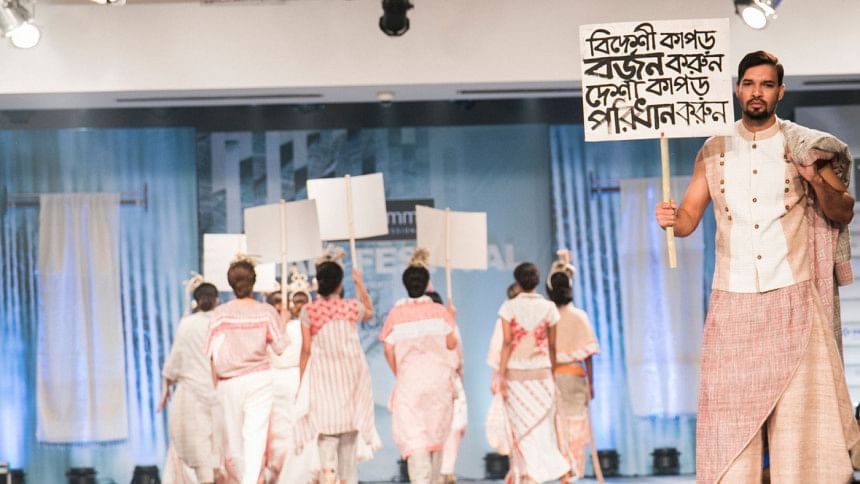
Bangladesh's fashion industry is going through a very exciting time, with people always pushing the limits and finding new ways to showcase their creative zeal. The Fashion Design Council of Bangladesh (FDCB) is a non-profit organisation dedicated to showcasing to the world the amazing things those Bangladeshi designers are accomplishing.
There are always new additions to this prestigious organisation, with the newest additions like Tanha Sheikh, Ajijur Raihan, Imam Hassan, Kamrul Riad, Rukshana Esrar, Nahida Muna, Sadia Rupa, Madhuree Sanchita Smrity, and others. To celebrate their addition to the pool and to showcase their amazing talents, FDCD is organising a fashion show, titled "The Impossible Collection of Fashion," which is set to take place on 4 November, and Star Lifestyle had the exclusive opportunity to gain designers' insight on their journeys and the thought process behind their work, which will be showcased in a few days.
Ajijur Raihan: A promising name in the fashion industry
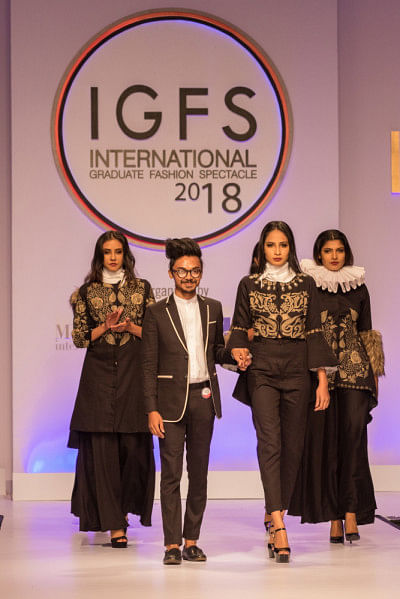
Ever since he was a child, Ajijur Raihan felt drawn towards fashion and the glamour world. Back when being a doctor or engineer was the only way to get up the success ladder, Raihan knew that was not his destiny. Following his passion, he completed his Bachelors in Fashion Designing, and he credits everything that he has learned so far to all the late-night portfolio preparations that were a big part of his university days.
When it comes to designing, Raihan is an avid believer of experimenting. In his words, "Life is too short to not experiment with your clothes". From patterns, to shapes to materials, you would notice something different, out of the box in all his collections. He often feels that people fear experimenting with fashion and that's what holds them back from setting trends.
In this competitive industry, he knows that one has to stand out to create a design that will set one apart from the rest. Keeping that thought in mind, he always tends to go for designs that tell their own story. He believes that patterns can represent an era of time, colours can help feel the beauty of a season.
Recently, Raihan has found a new love for sci-fi elements in his designs. Ever since the pandemic lockdown, he noticed that people's fashion preferences were changing rapidly and everyone was leaning more towards science and technology. Upon this realisation, he decided to experiment with technology, and has dedicated his time to find the perfect blend of fashion and technology in his designs.
Currently prepping for his upcoming show in November 2022, Raihan hopes to end the year on a positive note and excitedly awaits the fashion trends that will be coming soon and revamp the fashion industry.
By Maisha Tarannum Iqbal
Photo: Ajijur Raihan
Imam Hassan: From dreamer to designer
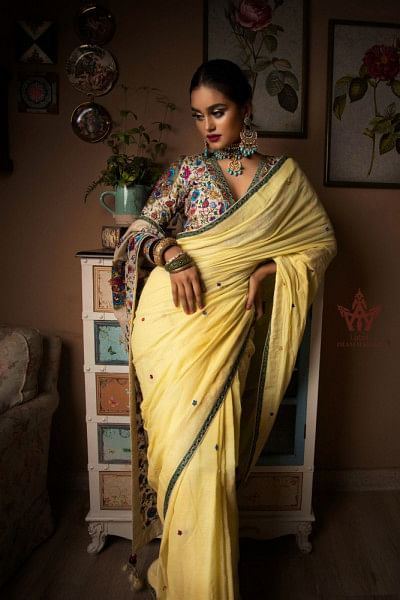
Imam Hassan has loved fashion and everything about it for as long as he can remember. Even has a child, he was fascinated by the foreplay of colours and intricate details in handcrafted clothes, and accessories.
Upon completing his HSC exams, Hassan set out on pursuing his dream of becoming a fashion designer by joining Bibiana as assistant designer. It was also his experience at Bibiana and the vision of veteran designers like Bibi Russell and Lipi Khandker that inspired Hassan to focus his work on local fabric. Another mentor and inspiration for Imam Hassan was the renowned artist and designer, Chandra Shekhar Shaha.
Hassan obtained his formal training and education on fashion designing from Shanto-Mariam University of Creative Technology (SMUCT) and has had the opportunity to work with various fashion houses, his experience eventually leading him to launch his own brand — Label Imam Hassan.
"The absolute favourite part about my profession is being able to help my clients create the look they dream of with our local fabric and craftsmanship," says this designer.
Imam Hassan has also been associated as head designer at the Friendship Colours of the Chars, a social enterprise of Friendship NGO, promoting sustainable fashion.
Hassan's dream of representing the colours and culture of Bangladesh stretches well beyond the simple and aesthetically pleasing rickshaw art. "I think we can all agree that our lifestyle has evolved from the simplistic representation we still see in various platforms," he says.
Imam Hassan is also among the more recent members of Fashion Design Council of Bangladesh. He believes that a country's fashion council paves the way for designers to showcase their work on international platforms and FDCB is all set to make its worthy contribution in Bangladeshi fashion.
By Nusrath Jahan
Photo: Imam Hassan
Kamrul Riad: His journey into the world of colours and shapes
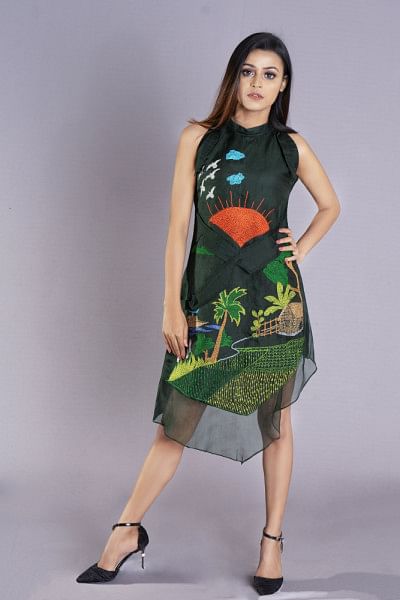
Kamrul Riad is one of the new faces in the industry and is at the forefront of the new fashion movement, currently working for NZ group, while also showcasing his creative prowess through the brand, D.code by Riad.
Kamrul was inspired to enter the realms of fashion designing by Bangladesh's diverse heritage. "We are a very colourful culture indeed. We have Muslims, Hindus, Buddhists, and Christians, as well as many small indigenous groups, each having their own set of traditional costumes. On top of that, there is so much variety in local textile and local surface designs. Why would anyone not want to create something new out of them?" he stated.
Kamrul is always looking to bring his vision to life. His designs are heavily influenced by the season, so he factors that at first. "Next, I think of my target group and come up with a theme based on that and the season. I then do research to pick out the surface design and shade," explained Kamrul.
Kamrul's creativity and unique approach has gained a lot of praises and fan following. He was a top five finalist at WorldSkills Rising Star Competition in 2019. He is also one of the newest additions to the Fashion Design Council of Bangladesh.
"I feel blessed to be a member of FDCB, the best platform in Bangladesh to display our work", he stated. Kamrul's work will be displayed in FDCB's upcoming event, titled Emerging Designers to your Grass roots. For the fashion show, he will be working with geometric designs.
Kamrul's use of colour as well as his eye for motif-shape-placements truly make his creations standout. It will be exciting to see what he brings to his upcoming fashion show.
By Irfan Aziz
Photo: Kamrul Riad
Madhuree Sanchita Smrity: Her own world of fashion
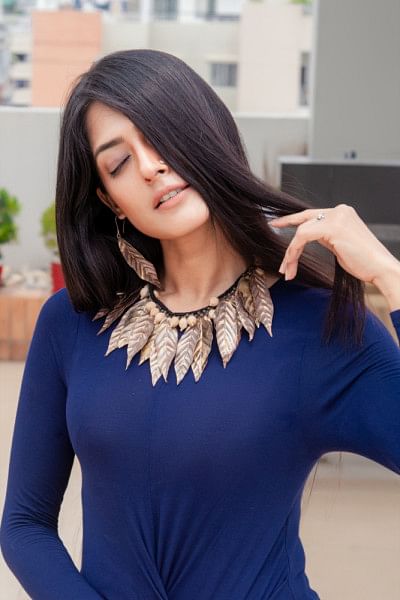
The first inspiration for Madhuree Sanchita Smrity came from her mother, who would do thread work on dresses and often get her involved by asking her to draw out the designs. Over the years, Smrity found herself more in the world of art and fashion, and once she joined the Faculty of Fine Arts at the University of Dhaka, there was no looking back.
During her Charukola days, Smrity joined the team of the most renowned puppet show of Bangladesh, Sisimpur. She continued puppetry for roughly five years, all the while completing her Bachelor's and Master's. Afterwards, she joined Rang, officially taking her first step in the world of fashion. Smrity joined Jatra in 2010 and Anusheh Anadil became her mentor in her journey of becoming a designer.
"I will always be immensely grateful to Anusheh. She tirelessly taught me everything there is to know about fashion designing," says Smrity. After seven years of working with Jatra, it was time for her to broaden her horizons.
Other than Rang and Jatra, Smrity has also been associated with brands like Aarong and Aranya, having worked long periods of time with both of these fashion houses.
Madhuree Sanchita ultimately found her own niche in jewellery making, beginning her own enterprise, Rhree, in January 2020. What is exceptional about this particular creation of hers is her use of natural seeds in making the jewellery.
In addition to using natural colour, Smrity has worked with a variety of over 50 different types of seed in her jewellery.
"Women are a part of the cycle of nature," says Smrity, "So creating Rhree and working with natural ingredients like seeds is a way of reflecting the women's involvement in nature," she said.
Smrity has been an active part of Fashion Design Council of Bangladesh (FDCB) for the past four months and feels excited to be working in a platform that allows her to interact with designers and aspiring artists of different age group and experience.
By Nusrath Jahan
Photo: Tamim Ahmed
Nahida Muna: Fashion through her perspective
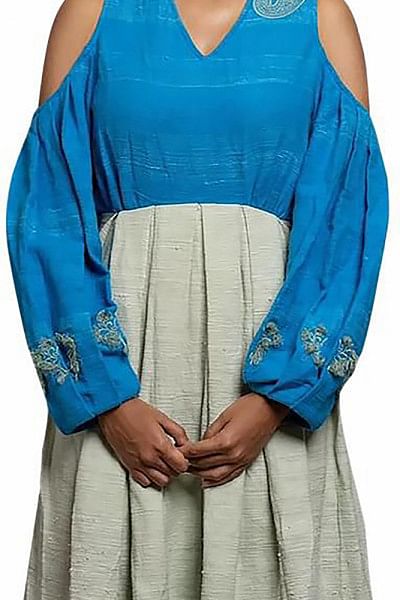
Coming from a business background, Nahida Muna never planned on pursuing a career in fashion designing. However, destiny had other plans.
Realising her potential in sketching, one of her friends suggested that she pursue a Bachelor's degree in fashion designing. As she was never a fan of conventional career options and always had a keen eye for fashion, she decided to go for it.
Back when she started, people were not so fashion conscious as they are now. It was not a part of our everyday life, but Nahida took it as an opportunity to change the narrative.
In 2012, when fashion was largely considered a luxury only for the elites, she knew she had to do something to make fashion more accessible to everyone.
A fan of the legendary designer Bibi Russell, she started getting inspiration from her and began experimenting with simple yet trendsetting patterns, and designs that people can add to their everyday wardrobes. She believes fashion does not always have to be flamboyant. She prefers working with simple motifs that stand out because of its pattern, colour, or even shape.
In her 10 years of experience in the industry, she has witnessed a significant change in how fashion is viewed among the masses. She is overjoyed to see that, regardless of any occasion, people now give a lot of thought to fashion and do their best to stay updated with recent trends.
Encouraging the upcoming designers who want to pursue a career in the fashion designing industry, she advises them to make the best use of their creativity and skills. In her words, fashion is something that people of all ages and generations enjoy.
By Maisha Tarannum Iqbal
Photo: Nahida Muna
Rukhsana Esrar: Luxury clothing
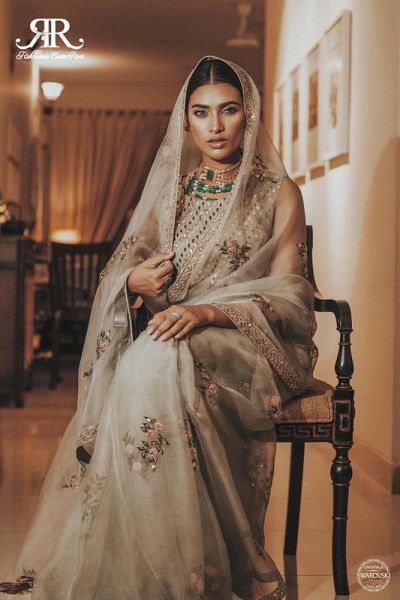
When you buy designer clothes, you do not pay for just the attire, you also get a personalised tailoring (quite literally) just for you. A lot of thought and effort is put behind the little details and intricacies that make the whole process what it is.
The owner of RER (Rukhsana Esrar Runi), Rukhsana Esrar has been navigating the ins and outs of the fashion world for the past 30 years. She specialises in haute couture bridal dresses, which is complex due to its bespoke nature but that's what makes her creations stand out.
"The start of my journey was purely out of necessity but as time went by, I fell in love with designing," explained Rukhsana. She has always had an appreciation for the finer things in life and started incorporating that into her work.
Now, bringing intricate creations to life obviously involves a lot of elaborate steps, and Rukhsana gave us an insight into her world. She usually starts with mood boards, colour palette and sketches. Next comes sourcing the material.
"Once I get the initial steps out of the way, I get into cutting, sewing, printing, embroidering, sampling, finishing, and finally production," she elaborated.
Rukhsana Esrar is one of the newest members of the Fashion Design Council of Bangladesh (FDCB).
"I'm honoured and grateful to be in the same league as these incredibly talented individuals. I feel proud of the initiatives we have taken to uphold Bangladeshi fashion, its artisans, and materials and ensure a brighter future for them," she replied, when asked about addition to FDCB.
For the upcoming fashion show, she is working on a collection that will showcase the strength and lustre of Bangladeshi silks to the rest of the world.
By Irfan Aziz
Photo: Rukhsana Esrar
Sadia Rupa: A voice of the Bangladeshi fashion industry
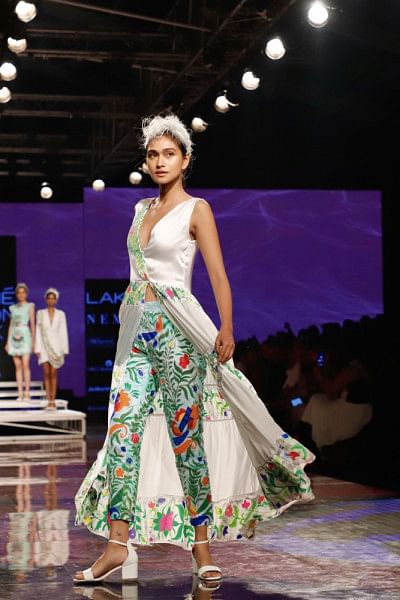
Sadia Rupa's collection of ethnic, western and fusion dresses for both men and women take Bangladeshi heritage to an international platform, upholding social and global fashion trends. By manipulating fabric, mixing and matching different motifs and patterns, her brand Sadia Rupa (SR), integrates stories, traditions, social values and norms, and customs backed up by proper research.
Sadia Rupa's journey started back in 2011 while she was working as a freelance costume designer for Channel-i. While her initial goal was never in fashion designing, she considers herself lucky to have found her passion and making space for herself in the industry.
With a background in both accounting and fashion, she chose to pursue a Master's degree in fashion designing from India. During that time, her success in the 2020 Lakmé LaunchPad earned her the title as the first Bangladeshi designer to win the competition. Later on, she went to participate in the Lakmé Fashion Week in Mumbai as an international designer. Sadia represented Bangladesh in both shows using rickshaw art and traditional textiles. She later went on to participate in New York Fashion Week, the hub of all fashion designers and fanatics, as a costume designer.
With a knack for playing around with designs and patterns and appreciating a creative challenge, her main focus in her work is product quality, sustainability, and environment.
"I always try to harmonise Bangladeshi heritage into my designs, which will reflect our culture internationally. I want my designs to speak of my country," said Sadia.
Using sustainable and high-quality fabrics like organic cotton, natural silk, khadi, linen, Sadia tries to capture her interpretation of what she sees around her and how it resonates within her.
Her journey so far is not only an achievement for herself but for the entire nation in gaining representation on global platforms and enriching Bangladesh's fashion industry.
By Puja Sarkar
Photo: Sadia Rupa
Tanha Sheikh: Her approach to sustainable fashion
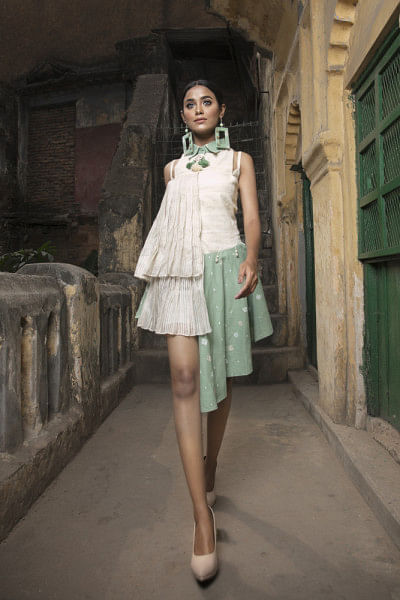
Sustainable fashion is often talked about in opposition to fast fashion, which is known to contribute to environmental pollution. Many Bangladeshi designers, including Tanha Sheikh, are embracing sustainable fashion, while keeping in mind to engage the youth with intricate designs and modern trends. She believes that this new way to fashion and sustainability can produce garments with longevity and embody cultural stories.
Tanha's journey in the creative field began during her childhood. Growing up in a culturally rich environment, she always had an affinity for art, craft, and nature. Her passion to work in fashion and her motivation to revive Bangladeshi traditional arts led to the creation of her clothing line, Taan, in 2016, while pursuing a Master's in Fashion Design from Shanto-Mariam University of Creative Technology.
Realising the harm that the fashion industry inflicts on the environment, she chose to evade all practices contributing to climate change in her work. Despite the cost increases and challenges, her aspirations and her duty to inspire the youth to embrace Bengali traditions and stay connected to our heritage, kept her motivated.
Tanha firmly believes that developing something from a classical perspective does not lessen how rich the design is. Her collection, 'Tepa Putul,' digs deep into integral parts of Bangladeshi culture through modern designs. Her collection used AZO-free materials, meaning the entire manufacturing process was free from using toxic chemicals like bleach and nitrogen.
With her upcoming collection, she intends to travel across Bangladesh, gathering experience and information from local artisans, and the indigenous population. Currently focusing on women's and menswear, she hopes to expand to the home decor sector.
In the coming years, Tanha aspires to start a foundation for artists to directly sell to local and international customers to earn better and increase the value of their work. She additionally is looking to work in the field of women empowerment through evidence-based information and technology allowing women to create market-friendly products.
By Puja Sarkar
Photo: Tanha Sheikh

 For all latest news, follow The Daily Star's Google News channel.
For all latest news, follow The Daily Star's Google News channel. 


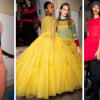
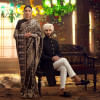




Comments